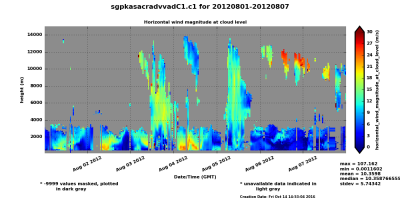New Scanning ARM Cloud Radar – Advanced – Velocity Azimuth Display (SACR-ADV-VAD) Product Released to Evaluation
Published: 16 February 2016

The Scanning ARM Cloud Radar-Advanced-Velocity Azimuth Display (SACR-ADV-VAD) value-added product (VAP) provides profiles of horizontal wind estimates at cloud level, using observations from the Hemispherical Sky Range Height Indicator (HS-RHI) scan strategy of the Ka-Band Scanning ARM Cloud Radar (KASACR).
The VAD technique was historically used to retrieve wind field properties using weather radars. SACR-ADV-VAD employs the technique using three horizon-to-horizon HS-RHI scans, typically repeated one to two times per hour, and spaced by 30 degrees in azimuth. The resultant product has a 30- to 60-minute time resolution and a 50-meter height resolution. It is intended to complement infrequent soundings, routinely only 2 to 4 per day, depending upon the site.
SACR-ADV-VAD relies on SACR radial mean Doppler velocity observations from the SACRCOR VAP, which are corrected for aliasing, noise, insects, and second trip echo.
The SACR-ADV-VAD evaluation product is available as a daily NetCDF file. It is produced for the month of August 2012 at the Southern Great Plains (SGP) megasite, and for the month of September 2012 in Cape Cod, Massachusetts, during the Two-Column Aerosol Project (TCAP).
For questions or to report data problems, please contact Scott Giangrande. To access the data, please browse the ARM Data Archive. (Go here to create an account to download the data.)
# # #
The ARM Climate Research Facility is a national scientific user facility funded through the U.S. Department of Energy’s Office of Science. The ARM Facility is operated by nine Department of Energy national laboratories.
The ARM Climate Research Facility is a DOE Office of Science user facility. The ARM Facility is operated by nine DOE national laboratories, including .
Keep up with the Atmospheric Observer
Updates on ARM news, events, and opportunities delivered to your inbox
ARM User Profile
ARM welcomes users from all institutions and nations. A free ARM user account is needed to access ARM data.


















